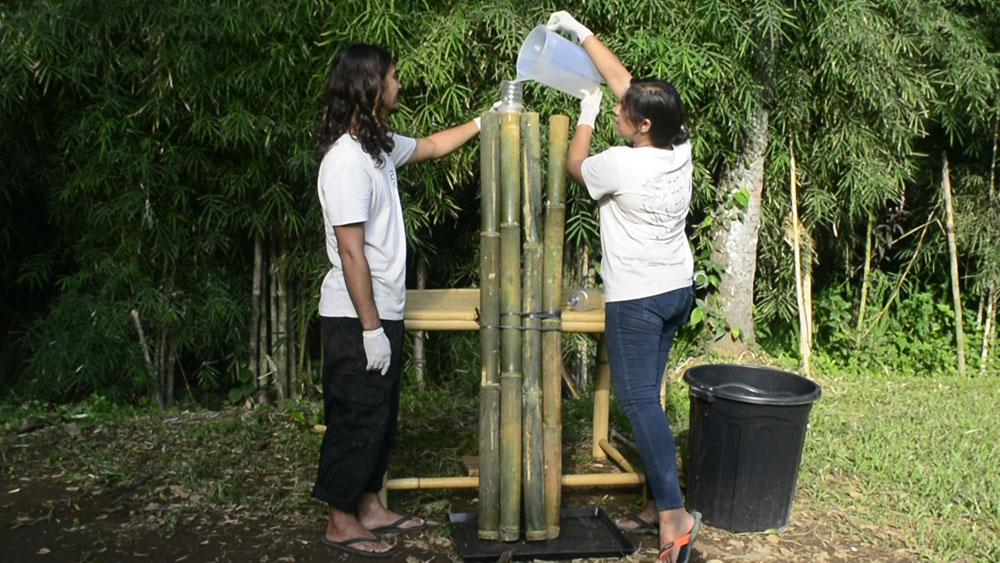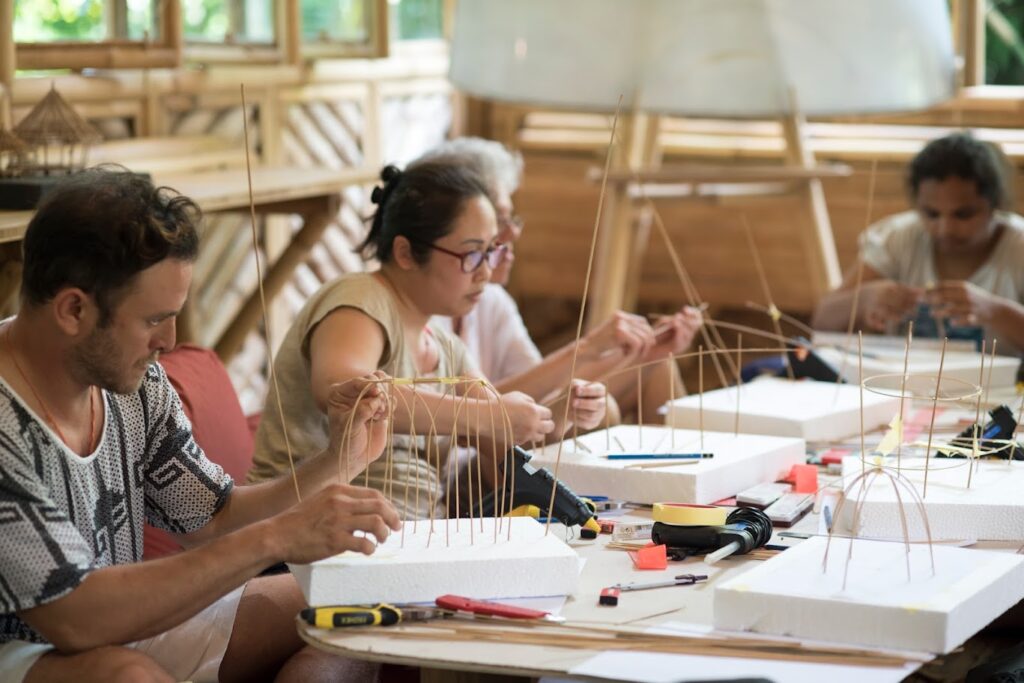5 Roofing Systems For Bamboo Buildings

Roofings are perhaps the most fundamental architectural element of bamboo buildings (together with foundations). Well-designed and built roofs play a key role in protecting a bamboo structure whilst adding to the beauty and experience of the space.
What qualifies as a well-designed bamboo roof?
There are a couple of key elements that need to be considered: 1) the overhangs of the roof to mitigate the weathering of bamboo poles from direct sun and rain (we will tackle this topic in a future article), 2) the pitch of the roof for water flow and 3) the spacing of the rafters for rigidity, and finally, 4) the material used.
Here in Bali, we have experimented with many different roofing materials and techniques. In this article, we share 5 of the most commonly used roofing systems for our bamboo buildings.
5 Roofing Systems For Bamboo Buildings
- Thatch
- Halved bamboo
- Terracotta tiles
- Flattened bamboo shingles
- Copper shingles
1. Thatch Roof (known locally as alang alang)
Alang-Alang roofs are a traditional thatch roofing technique used in Indonesia. The Congo grass (Imperata cylindrical) is harvested when mature and dried. Then, thatch panels of a maximum of 3 meters in length are made by folding the dry grass over a bamboo split and threading it onto the split using palm fiber.
The bamboo split gives structure to the grass turning it into a panel whilst also acting as a roofing batten. When installed the alang alang panels are tied to the rafters using a lashing technique with bamboo rope.
For a well-designed bamboo building that uses an alang alang roof, the roof pitch should be around 45 degrees for water to run off and we recommend that the rafters are installed no further than 60 cm apart to keep the roof from sagging.
Alang alang roofs are flexible and complement curvilinear roofs well. Thermal insulation is the most attractive benefit of this roof type. It has an incredible ability to breathe, and release warm air whilst keeping the air cool inside.
In Bali, today (2021), this roof costs around USD$15 - $17 (250,000 IDR) per sqm to build (this number fluctuates a little) making it quite affordable. The downfall of this roofing system is that it requires high maintenance. Alang -alang roofs need to be replaced every 3-7 years. Historically alang alang roofs would last up to 10 years, but because nowadays farmers are harvesting the grass before it is mature, the grass is weaker and therefore degrades faster. The durability of this roofing system depends highly on harvest time, moisture, and organic matter build-up from the rain, tree cover, and animal droppings.
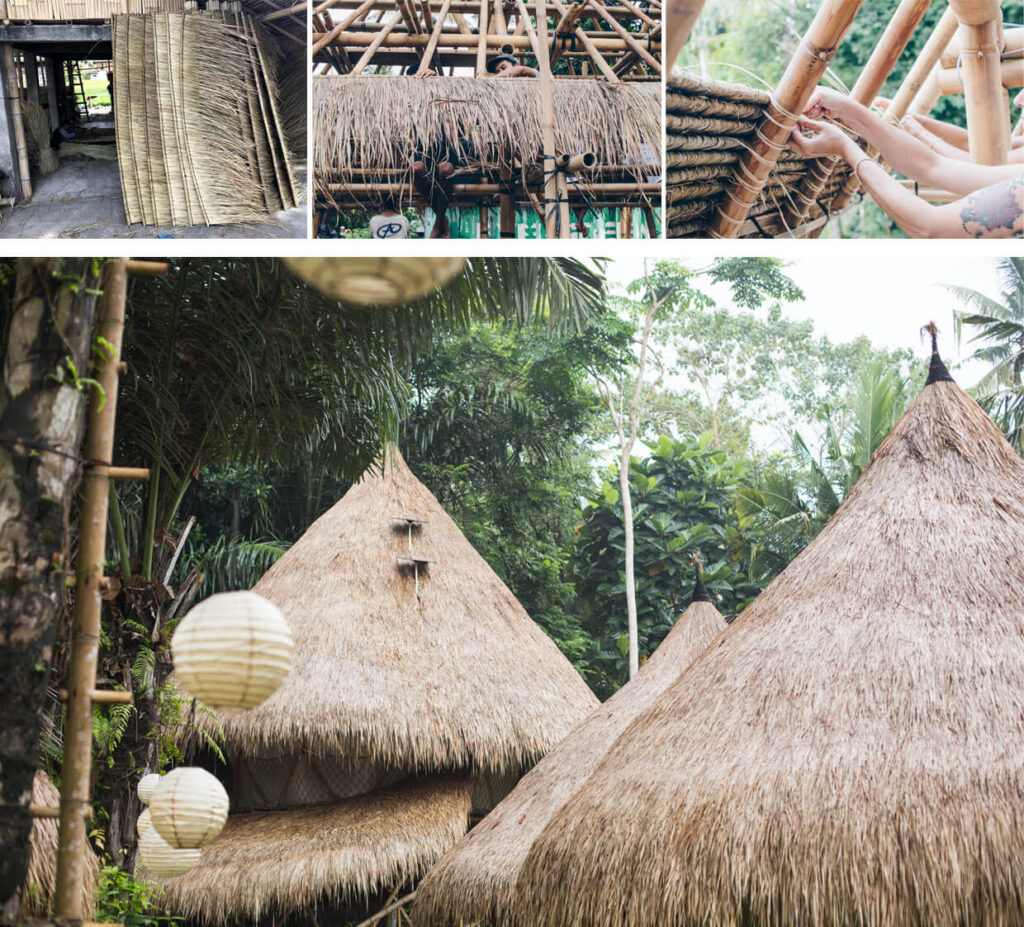
2. Halved Bamboo Roof
The halved bamboo roof is made up of freshly harvested bamboo poles split into two halves and placed in an interlocking sequence similar to a Spanish tile roofing technique.
For a well-designed bamboo building using halved bamboo, the roof needs a minimum roof pitch of 40 degrees and the rafters should not be placed further than 60 cm apart from one another. Finally, the roof ridge should be covered properly.
To make your bamboo building last longer, you can also use 3 layers, the first layer woven bamboo mats locally known as bedeg over the rafters for interior aesthetics, then asphalt linear) and cladding of half bamboo as a final layer.
This roof works with slightly curvilinear and small structures, but it is hard to use this technique for large and complicated curved roofs. We use Gigantochloa apus poles for this roofing and Dendrocalamus asper to cover the roof ridge.
This roofing system also requires high maintenance and needs to be replaced every 5 years. The bamboo degrades quickly if it is exposed to moisture or organic matter.

3. Terracotta Tile Roof
Terracotta tiles are the most durable roofing material. Roofs of this kind can last for 100 years. Terracotta tiled roofs are very heavy and therefore during design, this added load must be accounted for.
For a well-designed bamboo building using a tile roof, we recommend a minimum roof pitch of 35-degrees and rafters should not be placed more than 30 cm apart. Battens (or laths) must be added to hold the tiles over the rafters.
Tile roofs only work for linear buildings and maintenance is pretty minimal; some clearing of organic matter and replacing broken tiles that might have encountered impact from a fallen branch (or a durian ;).

4. Flattened Bamboo Roof (Known Locally As Pelupuh)
Pelupuh is handwrought flattened bamboo made into roofing shingles and it is made by cutting a Gigantochloa apus bamboo pole in half lengthwise. Then a cut is made into the culm wall from the inside out using a hatchet. The cuts do not pierce through the entire culm wall, just enough so that the section of the culm is flattened out. The cuts should be made at an angle to prevent splitting in the structure of the bamboo. The nodes are then shaved off using a bamboo knife or hatchet.
We use this processed bamboo material in a 3 layered hybrid roofing technique where we first place treated pelupuh over the rafters for interior aesthetics, then an asphalt linear (synthetic waterproofing membrane) and pelupuh which is cut to size as roofing shingles as a final layer. All layers are attached using a nail gun.
For a well-designed bamboo building using a flattened bamboo roof, we need to have a minimum 40 degree roof pitch and rafters should not be placed more than 40 cm apart.
Flattened bamboo is very flexible and works nicely with curvilinear roofs. The synthetic waterproof membrane lasts for 20-25 years, but the outer bamboo pelupuh layer must be replaced every 5-8 years. Flattened bamboo degrades quickly if it is exposed to moisture and organic matter.

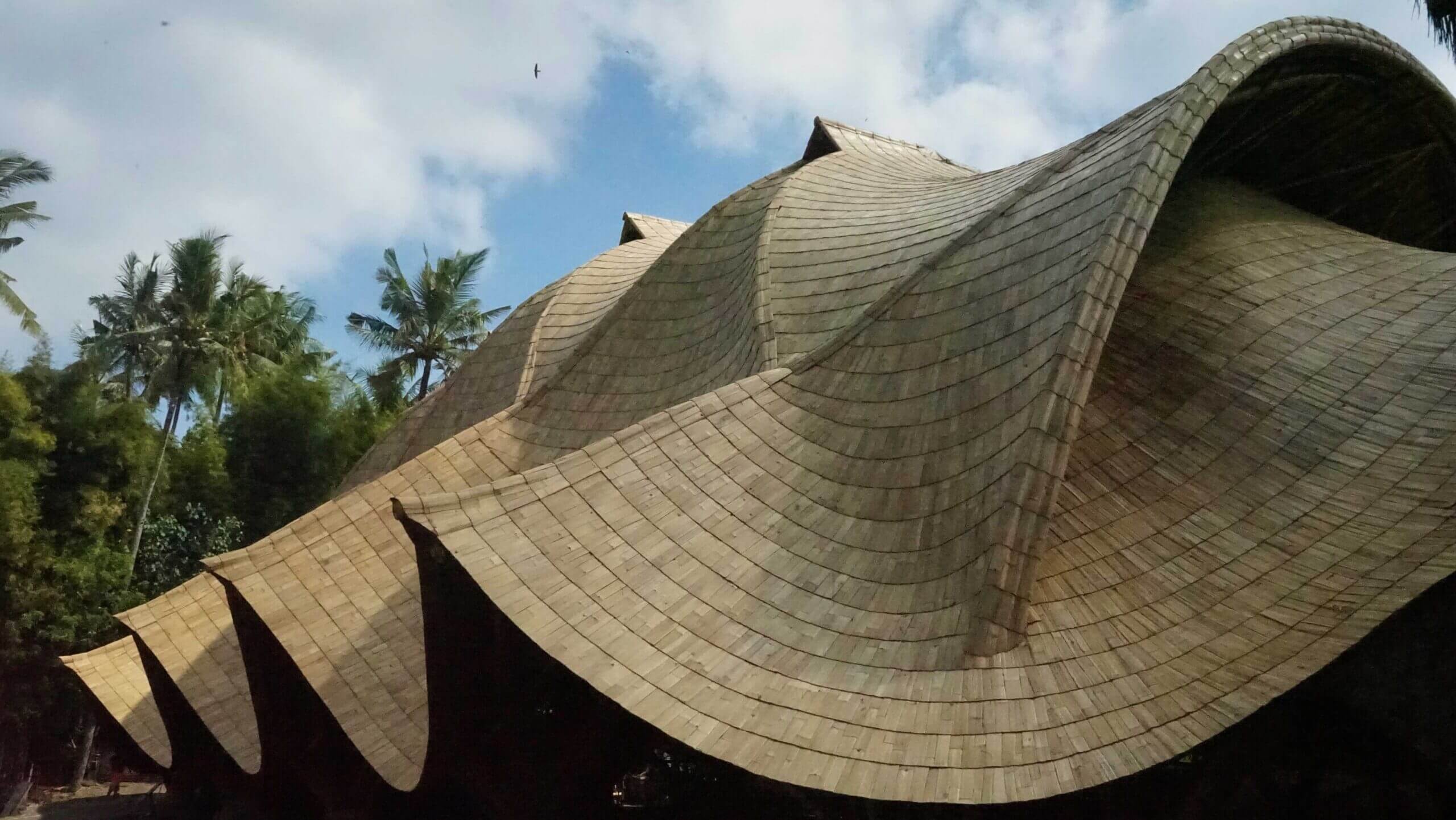
5. Copper Roof
Copper roofing is a recent experiment for bamboo structures pioneered by John Hardy and IBUKU. It is durable but very costly. The copper sheets are customised as tile shingles on the ground by hand and put in place on the roof.
For a well-designed bamboo building using a copper bamboo roof, we recommend a minimum pitch of 15 degrees, and rafters should not be placed more than 60 cm apart.
When constructing a copper roof, pelupuh are first placed over the rafters for interior aesthetics, an asphalt liner is then attached using a nail gun, and cladding of customised hand-cut copper tile shingles are placed as a final layer (see in pictures below).
The copper roof is very flexible and works nicely for curvilinear roofs.
Copper roof buildings look very beautiful, even when weathered over time, when a lovely patina forms. This roofing system does not require maintenance.
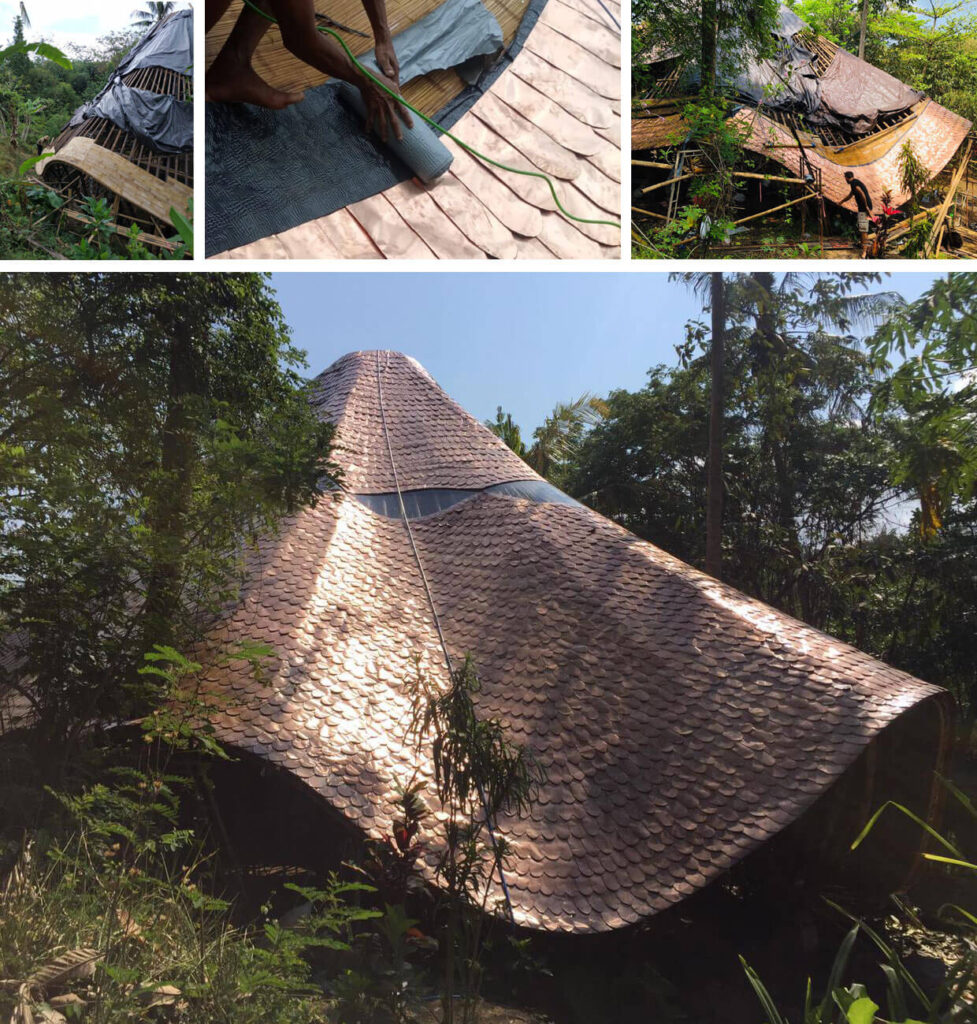
Roofing is a very important element of bamboo construction and requires balancing a desire for sustainability, beauty, and durability.
Interested in learning more about designing and building with bamboo? We will be taking a deeper look at all of these topics and more during our bamboo courses and workshops online and in Bali. See our upcoming courses here:

Maria is the Bamboo U Director and Sai Goutham is the Research & Development Manager. Together they formulate ideas, write content and create illustrations to share knowledge of bamboo architecture and design.
June 7-18, 2024
The 11 Day Bamboo Build & Design Course in Bali
In 11 days, we'll show you how to build bamboo structures we’ll share all that it takes to build with nature.
April 26, 2024
The Fundamentals of Building with Bamboo Online Course
All the fundamentals you need to get you started working with bamboo. Deep dive into cinematic videos and step-by-step guides that will provide you with a strong understanding of bamboo as a design and building material.


